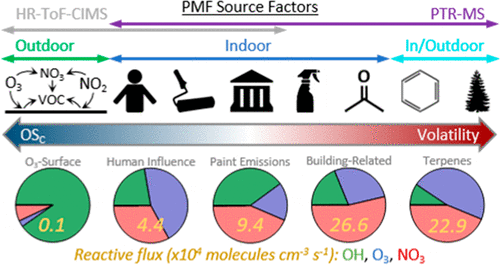当前位置:
X-MOL 学术
›
ACS Earth Space Chem.
›
论文详情
Our official English website, www.x-mol.net, welcomes your feedback! (Note: you will need to create a separate account there.)
Sources of Gas-Phase Species in an Art Museum from Comprehensive Real-Time Measurements
ACS Earth and Space Chemistry ( IF 3.4 ) Pub Date : 2021-08-25 , DOI: 10.1021/acsearthspacechem.1c00229 Derek J. Price 1 , Douglas A. Day 1 , Demetrios Pagonis 1 , Harald Stark 1, 2 , Anne V. Handschy 1 , Lucas B. Algrim 1, 3 , Shelly L. Miller 4 , Joost A. de Gouw 1 , Paul J. Ziemann 1 , Jose L. Jimenez 1
ACS Earth and Space Chemistry ( IF 3.4 ) Pub Date : 2021-08-25 , DOI: 10.1021/acsearthspacechem.1c00229 Derek J. Price 1 , Douglas A. Day 1 , Demetrios Pagonis 1 , Harald Stark 1, 2 , Anne V. Handschy 1 , Lucas B. Algrim 1, 3 , Shelly L. Miller 4 , Joost A. de Gouw 1 , Paul J. Ziemann 1 , Jose L. Jimenez 1
Affiliation

|
Indoor gases in an art museum were measured by two real-time chemical ionization mass spectrometers (CIMS; iodide (I-CIMS) and nitrate (NO3-CIMS) reagent ions) and a proton-transfer-reaction mass spectrometer (PTR-MS). A positive matrix factorization (PMF) analysis isolated nine different factors capturing the variability. Three factors were observed by all instruments, comprising over 30% of the organic carbon from each instrument. Of these three, one factor correlated with CO2, indicating a clear influence from human occupancy, and another was dominated by small carboxylic acids and was likely related to building materials. The third factor was dominated by HONO and ethylene glycol, with strong emission signatures after gallery painting. Additional factors correlated with ozone (O3) and nitrogen dioxide and are suggestive of indoor surface reaction products from outdoor-related oxidants. Outdoor-related factors contributed 20% of the measured organic carbon. Organic nitrogen compounds were measured and found to correlate with the estimated nitrate radical (NO3) concentration. The PTR-MS/I-CIMS/NO3-CIMS factors had higher, medium, and lower estimated volatility, respectively, while the carbon oxidation state followed the opposite trend. The majority of the VOC reactivity was due to indoor-related factors (52–77%) for all oxidants except O3 (44%). Human occupancy increased the reactivity of the human-related (×14), small acid (×1.5), terpene (×2), and acetone (×5) factors. The lifetime of oxidant reactivity (τOxR) against each oxidant for all factors was greater than the museum ventilation time scale, indicating that the reactivity from indoor sources is largely removed outdoors. The dominant VOC fates for all identified sources were ventilation and surface deposition.
中文翻译:

综合实时测量的艺术博物馆气相物种来源
通过两台实时化学电离质谱仪(CIMS;碘化物 (I-CIMS) 和硝酸盐 (NO 3 -CIMS) 试剂离子)和质子转移反应质谱仪 (PTR-MS)测量艺术博物馆的室内气体)。正矩阵分解 (PMF) 分析分离出九个不同的因素来捕捉可变性。所有仪器均观察到三个因素,包括每个仪器超过 30% 的有机碳。在这三个因素中,一个因素与 CO 2相关,表明受人类居住的明显影响,另一个以小羧酸为主,可能与建筑材料有关。第三个因素主要是 HONO 和乙二醇,在画廊绘画后具有强烈的排放特征。与臭氧相关的其他因素 (O3 ) 和二氧化氮,并且暗示了室外相关氧化剂的室内表面反应产物。户外相关因素贡献了 20% 的测量有机碳。测量有机氮化合物并发现其与估计的硝酸根 (NO 3 ) 浓度相关。PTR-MS/I-CIMS/NO 3 -CIMS 因子分别具有较高、中等和较低的估计挥发性,而碳氧化态则遵循相反的趋势。对于除 O 3 (44%)之外的所有氧化剂,大部分 VOC 反应性是由于室内相关因素 (52–77%) 所致。人类入住增加了人类相关(×14)、小酸(×1.5)、萜烯(×2)和丙酮(×5)因素的反应性。氧化剂反应寿命(τOxR ) 对所有因素的每种氧化剂都大于博物馆通风时间尺度,表明室内源的反应性在室外大部分被去除。所有确定来源的主要 VOC 归宿是通风和表面沉积。
更新日期:2021-09-16
中文翻译:

综合实时测量的艺术博物馆气相物种来源
通过两台实时化学电离质谱仪(CIMS;碘化物 (I-CIMS) 和硝酸盐 (NO 3 -CIMS) 试剂离子)和质子转移反应质谱仪 (PTR-MS)测量艺术博物馆的室内气体)。正矩阵分解 (PMF) 分析分离出九个不同的因素来捕捉可变性。所有仪器均观察到三个因素,包括每个仪器超过 30% 的有机碳。在这三个因素中,一个因素与 CO 2相关,表明受人类居住的明显影响,另一个以小羧酸为主,可能与建筑材料有关。第三个因素主要是 HONO 和乙二醇,在画廊绘画后具有强烈的排放特征。与臭氧相关的其他因素 (O3 ) 和二氧化氮,并且暗示了室外相关氧化剂的室内表面反应产物。户外相关因素贡献了 20% 的测量有机碳。测量有机氮化合物并发现其与估计的硝酸根 (NO 3 ) 浓度相关。PTR-MS/I-CIMS/NO 3 -CIMS 因子分别具有较高、中等和较低的估计挥发性,而碳氧化态则遵循相反的趋势。对于除 O 3 (44%)之外的所有氧化剂,大部分 VOC 反应性是由于室内相关因素 (52–77%) 所致。人类入住增加了人类相关(×14)、小酸(×1.5)、萜烯(×2)和丙酮(×5)因素的反应性。氧化剂反应寿命(τOxR ) 对所有因素的每种氧化剂都大于博物馆通风时间尺度,表明室内源的反应性在室外大部分被去除。所有确定来源的主要 VOC 归宿是通风和表面沉积。


























 京公网安备 11010802027423号
京公网安备 11010802027423号